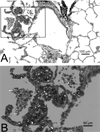Nanoparticles, lung injury, and the role of oxidant stress
- PMID: 24215442
- PMCID: PMC4408931
- DOI: 10.1146/annurev-physiol-030212-183735
Nanoparticles, lung injury, and the role of oxidant stress
Abstract
The emergence of engineered nanoscale materials has provided significant advancements in electronic, biomedical, and material science applications. Both engineered nanoparticles and nanoparticles derived from combustion or incidental processes exhibit a range of physical and chemical properties that induce inflammation and oxidative stress in biological systems. Oxidative stress reflects the imbalance between the generation of reactive oxygen species and the biochemical mechanisms to detoxify and repair the damage resulting from reactive intermediates. This review examines current research on incidental and engineered nanoparticles in terms of their health effects on lungs and the mechanisms by which oxidative stress via physicochemical characteristics influences toxicity or biocompatibility. Although oxidative stress has generally been thought of as an adverse biological outcome, this review also briefly discusses some of the potential emerging technologies to use nanoparticle-induced oxidative stress to treat disease in a site-specific fashion.
Figures




References
-
- Alivisatos P. Colloidal quantum dots. From scaling laws to biological applications. Pure & Appl Chem. 2000;72:3–9.
-
- Drexler KE. Nanosystems: Molecular, machinery, manufacturing, and composition. New York, NY: Wiley-Interscience Publication; 1992.
-
- Hu JT, Odom TW, Lieber CM. Chemistry and physics in one dimension: Synthesis and properties of nanowires and nanotubes. Accounts Chem Res. 1999;32:435–445.
-
- Lieber C. Nanoscale science and technology: Building a big future from small things. MRS Bulletin. 2003;28:486–491.
-
- Navrotsky A. Thermochemistry of nanomaterials. Nanoparticles Environ. 2001;44:73–103.
Publication types
MeSH terms
Grants and funding
LinkOut - more resources
Full Text Sources
Other Literature Sources

